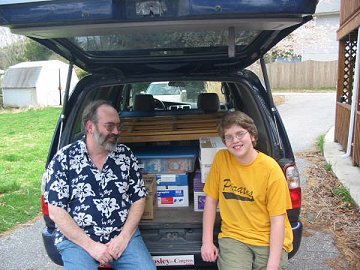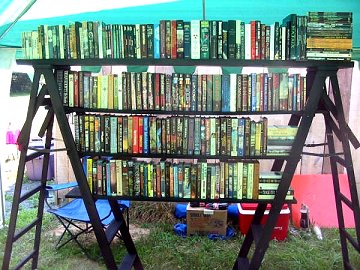

|
Bookselling at Science Fiction Conventions
|
|
In last month's column, I talked about the Where and Why of selling books at SF and Fantasy conventions. I noted that selling at the cons is an excellent way to profit from lower value stock that might not be worth selling online and that this kind of stock is readily and cheaply available at all the scouting venues that you already frequent. But it's important to realize that huckstering at the cons is not easy nor is it the right venue for just anyone. After reading these columns you should have a good idea if it's right for you. |

|
This month I'm going to focus on the How of convention bookselling. The key to success here is planning. There is quite a bit of logistics involved, so find out everything you can about the particular con you are attending. How big are the tables? How much floor space will you have? Is electricity available? Are table coverings provided (if the con is at a hotel then usually yes; otherwise, usually no)? Will staff (con or hotel) be available to help in unloading, and will handcarts or luggage carts be made available? The dealer room chairperson can answer these and any other questions you have.

Balticon is by far the largest SF convention in the Baltimore area, so I thought it would be a good idea to start off at a smaller con - a kind of dress rehearsal before the big show. A little bit of Internet research led me to JohnCon, an annual convention hosted by Hopsfa, the Johns Hopkins University Science Fiction Association. JohnCon is relatively small (about 200 members) and primarily a gaming and anime convention, which meant that the total number of potential customers would be low. However, it had several distinct advantages: the total dealer cost was a $9 con admission fee; I could have as many tables as I wanted; and I would be the only book dealer there.
Contrast this with Balticon: attendance was a healthy 1500+ members, but dealer cost was $100 per table; two and three table spots were limited and previous Balticon dealers were given preference; and there would be many book dealers attending. In fact, of the eight dealers adjacent to my space, four of them were booksellers.
One of the biggest logistical problems you will face involves storage and transportation of your stock. Bud Webster (The Joy of Booking: Webster's Guide to Buying and Selling Used SF and Fantasy Books; SRM Publisher, 2004 ISBN: 0972247351) suggests large, flat plastic bins - the under-bed storage kind - that are deep enough to pack your paperback stock. This has the advantage of providing easy storage, and the low flat bins also pack easily in the car. When you arrive at the con, simply arrange the bins on the table, pull off the lids, and you are open for business The bins I use measure about 32" by 13" by 6" and each holds between 60 and 70 average size paperbacks. My starting paperback inventory was approximately 450 books, stored in 7 bins.
Hardbacks are somewhat more difficult as the plastic bin trick just doesn't seem to work. Good old-fashioned cardboard boxes are still the most space efficient way to pack hardbacks. I would recommend getting standard sized boxes (copier paper boxes are ideal), as they are easier to stack and pack. The Xerox boxes will hold between 15 and 20 average size hardbacks, depending on how efficiently you pack. By the way, I would strongly recommend packing horizontally and not vertically, since you will inevitably need to stack boxes atop one another. My starting hardback inventory (and in this category I include oversize paperbacks) was approximately 300, packed in 14 boxes.
JohnCon was held on the undergraduate campus of Johns Hopkins University from April 8 to April 10, 2005. Registration was $9 in advance or $12 at the door. The con program consisted of 24 hour gaming, including role playing (Dungeons and Dragons, Mechwarrior, etc), board, and video, as well as a b-movie room, an anime festival, and live medieval combat with padded weapons.

As I mentioned earlier, dealer space at JohnCon was not an issue, and I was allowed as many tables as I wanted. I took two large tables, which I had absolutely no trouble filling. This was bad news because I had only paid for one table for the upcoming Balticon convention (more on my solution to this later).
Here is a summary of my sales for the JohnCon weekend. HB and PB are, of course, hardback and paperback; TPB is trade paperback. The "Sold" field indicates day one, two or three of the three day weekend.
| Day Sold | Format | Receipts | # Sold | Average Price |
|
| JHU1 | HB | $22.00 | 2 | $11.00 |
|
| JHU1 | PB | $27.00 | 2 | $13.50 |
|
| JHU2 | HB | $56.00 | 7 | $8.00 |
|
| JHU2 | PB | $57.00 | 21 | $2.71 |
|
| JHU2 | TPB | $12.00 | 2 | $6.00 |
|
| JHU3 | HB | $5.00 | 1 | $5.00 |
|
| JHU3 | PB | $35.00 | 12 | $2.92 |
|
| JHU3 | TBP | $5.00 | 1 | $5.00 |
|
Total | $219.00 | 48 | $4.56 |
Not a particularly impressive return on the amount of time and effort invested, even with a minimal amount of overhead (approximately $50 including cost of the stock sold).
I did learn a lot from JohnCon, though. First, there was no way one table was going to do for Balticon. I talked with some of the other dealers at JohnCon, one of whom was going to be at Balticon. She recommended that I find some way to "go vertical" with my stock since having it all laid out flat on table tops is visually unappealing and also more difficult for customers to see. This was great advice, and formed the basis of the subsequent solution to my space problem.
Another thing I learned at JohnCon is the importance of talking to people. In sales, half the battle is just getting the customer to stop long enough to look at what you have. Engage them in conversation, draw them out on what kind of fiction they like or their favorite authors or titles, and then make the sale. Some people are looking for something very specific - a missing title to complete a series, the new book by a particular author, etc. - which is fine if you have it. If you don't, then they are quickly off to the next dealer. But more often people are just browsing, looking for something to catch their eye. It's your job to get that book in front of them, and the best way to do that is by talking to them.
For those people who approach you and ask if you have this title or something by that author, it is a very good idea to have master inventory lists sorted by title and by author. The lists should include author, title, format, price, and notes (scarce, paperback original, no DJ, signed, etc.), plus two additional columns: Sold and Sold For. I use the Sold column to note when the book sold (e.g., JHU1 means first day of the JohnCon convention), while Sold For is the actual price I sold the book for. Usually the Price and Sold For columns are the same, but there were occasions where I ended up knocking a dollar or two off to make the sale. I found this method to be the simplest way to keep track of inventory sold. At the end of the con, I fill in these columns on a custom Access inventory database I maintain, and I can then do some simple analysis of sales, as well as removing sold stock from my active inventory.
You might also want to have an inventory list for stock that you didn't bring; you might still be able to make the sale and mail the book to the customer. I did this with my higher priced stock that I chose to leave home: collectible first editions, signed books, etc. Having that list helped me make a $95 sale at Balticon.
So, to sum up my JohnCon experience: I had a lot of fun, made some good contacts, and learned a lot. I just didn't make a whole lot of money while doing so.
After my experience at JohnCon, I knew I had a major problem. I needed at least two big tables for all of my stock, and I only had one available at Balticon. With the advice about "going vertical" in mind, I went out on the Internet looking for a solution. My first thought was to look at folding bookcases, but it quickly became apparent that they were too expensive and wouldn't provide the height and shelf space I wanted. Eventually I ended up looking at some websites that showed shelving systems for retailers. Lots of chrome and wire racks, or big and heavy shelf systems - all too big, too heavy, and too expensive.
But then I saw it. On a site for clothing store displays, I found a picture of a single wood A-frame with slats on each side and shelves that rested on the slats. In my mind's eye I saw two A frames, with shelves running between them. This was followed by the realization that the A frames were essentially nothing more than stepladders. I did some more checking around, and located six-foot high wooden stepladders at Ace Hardware for $32 each. I already had some decent boards to use as shelving, but appropriate stock for four shelves can be purchased for less than $20. I also realized to stabilize the system I would have to clamp the ends of the boards to the ladder rungs: eight 2-inch C-clamps ($2.00 each) for $16. Total cost for the shelving system was $100, or potentially much less if you already have any components available. I also decided to paint mine, using a matte black spray paint.

This system has some great advantages. To begin with, it is easy to assemble and tear down. Because it breaks down into components, it is very easy to transport, and it takes up very little room when stored away between uses. And once assembled and clamped down, it is extremely strong and stable. Finally, the shelves are high enough that the books are very visible and easy for the customer to get to.
The top shelf on my system is 7 feet long and 1" thick. The next shelf down is 6 feet long and ¾" inch thick. The two lowest boards are both five feet in length and ¾" inch thick. I did notice some bowing to the 6-foot board from the weight of the books, so it might be best to use (nominal) 2-by (actual 1 ½") stock, which is readily available at home centers, for long spans. (The 1" thick piece, by the way, was salvaged from a waterbed, and is not commonly available.) In all, my setup yields approximately 20 feet of shelving. If your average book is between 1 and 1.25 inches in width, this will accommodate approximately 200 books, give or take a few.
>>>>>Click here for page two>>>>
Questions or comments?
| Forum
| Store
| Publications
| BookLinks
| BookSearch
| BookTopics
| Archives
| Advertise
| AboutUs
| ContactUs
| Search Site
| Site Map
| Google Site Map
Store - Specials
| BookHunt
| BookShelf
| Gold Edition & BookThink's Quarterly Market Report
| DomainsForSale
| BookThinker newsletter - free
Copyright 2003-2011 by BookThink LLC
Contact the editor, Craig Stark
editor@bookthink.com
